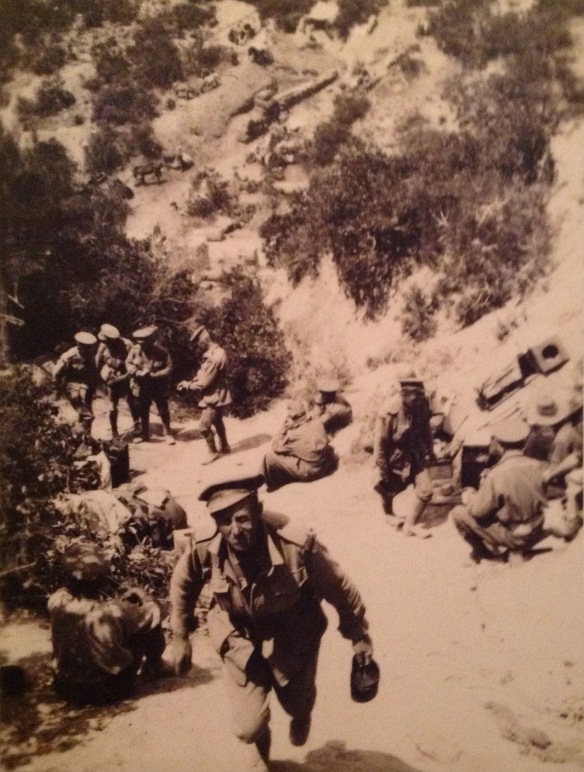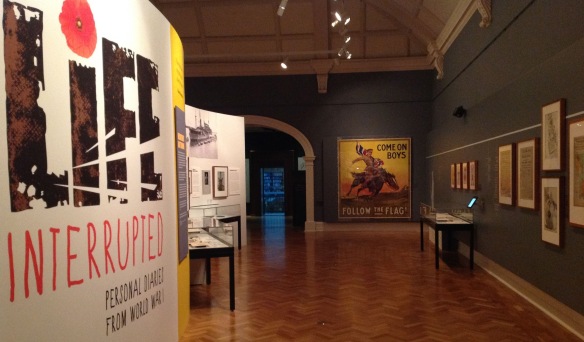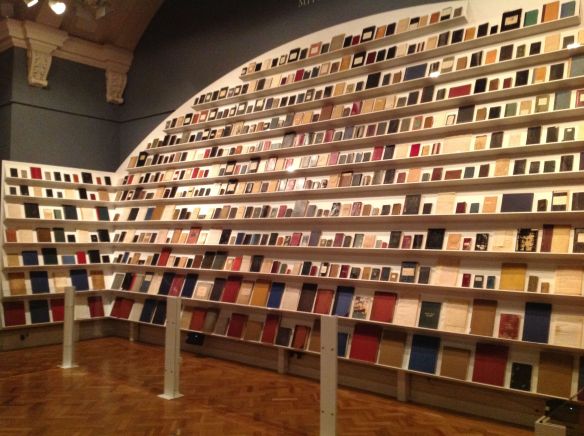5 Jul 2014 – 21 Sep 2014
Exhibition Galleries, State Library of NSW
I saw this wonderful exhibition at the State Library of NSW a few weeks ago.
From 1918 the State Library of NSW began collecting the WWI stories of servicemen, doctors, nurses, stretcher-bearers and journalists so that future generations would know about their experiences.
This extract from the exhibition program gives an insight into the Library’s collection:
By 1921 the total number of war diaries in the Library had reached 247, complemented by collections of letters and in some cases photo albums as well. Today the collection stands at around 550 diarists and over 1100 volumes.
A small number of diaries were acquired from the families of men killed abroad but the majority in this collection were purchased from men who made it home, survivors, many of them diarists over two, three or four years.
The diaries take many forms. Some were written on odd sheets of paper or in memo books or signal message books. Others were cloth or leather bound.
The soldiers, airmen, sailors and nurses who kept a diary, knew they had a big story to tell. For some their diary was a way to connect to home. They were writing for an imagined audience, for the family and friends they left behind. The importance of a ‘conversation’ with home can hardly be overstated. Along with letters and postcards and sometimes photographs, the diaries were the Facebook of their day.
Last but not least, these wartime chroniclers wanted a record of duty done. They wrote of hard times, of battle and death and ruin everywhere. There are lines, hastily scrawled upon the eve of battle, by soldiers who knew this entry might be their last.
These are voices full of life and fun and fear; and resolute purpose. They are voices from the greatest tragedy of the twentieth century, a tragedy that engulfed an age.
Peter Cochrane – July 2014
The exhibition Life Interrupted: Personal Diaries from World War I is beautifully curated by Elise Edmonds. The chronicle of the war is highlighted by the captivating personal accounts of those who enlisted – farmers, doctors, nurses, photographers and artists – and is supported by newspapers, photographs, artworks, maps and ephemera.
Many of the photographs in the exhibition are by Private Henry Charles MARSHALL (1890-1915) who enlisted in Sydney in the same week as my grandfather Ernest Clive BUCK (1895-1974). My grandfather’s service number was 571 and MARSHALL’s was 577. They were both in the Australian Imperial Force (AIF), 1st Infantry Battalion, E Company. They served together throughout training billeted at the racecourse at Kensington. They embarked on HMAT Afric out of Sydney for the Middle East.

Henry Charles Marshall (1890–1915). Kensington to Cairo and from Cairo to Gallipoli: Album of photographs, 1914–1915. [State Library of NSW PXA 1861]

Pitching tents in sight of pyramids, Henry Charles Marshall (1890–1915). Kensington to Cairo and from Cairo to Gallipoli: Album of photographs, 1914–1915. [State Library of NSW PXA 1861]

Uncaptioned photo of Australian servicemen at Gallipoli, Henry Charles Marshall (1890–1915). Kensington to Cairo and from Cairo to Gallipoli: Album of photographs, 1914–1915. [State Library of NSW PXA 1861]
Private MARSHALL’s, films, photos, letters and equipment were sent back to his family in Devonport, Tasmania. His father and sister organised the photos in chronological order and created an album using information in Henry’s note books as a photo index.
I believe the Marshall family offered copies of the photos and albums to the ex-servicemen of the 1st Battalion. My grandfather Ernest had an album, Kensington to Cairo, but not the Cairo to Gallipoli volume. Maybe he did not need photos to remember the horrors of the Gallipoli campaign.

This is why we wear our hats turned up on the side, Lieut PV Ryan (1881-1950). Sketchbook purchased by the State Library of NSW in 1919.
The exhibition doesn’t only focus on Gallipoli, it gives a voice to all the brave servicemen and women, from the beginning of the war in Ausust 1914, through all the desert campaigns of the Middle East and the muddy trenches of France.
One of the diaries featured in the exhibition is that of Anne DONNELL, a nurse stationed near Ypres, France. On New Year’s Day 1918 she sat on her bed and wept, homesick and exhausted. She had been away from home for three years. Sister Donnell was working in the acute medical ward. Her patients were mainly suffering from gas poisoning and there were lots of pneumonia cases. As she wrote in her diary, she could detect the smell of sickly sweet pineapple in the air – the tell-tale sign of poison gas:
‘10 p.m. Will this restless life never end. As I write the shelling is going on again – heavier too. I am not undressing – It’s a terrible life this’.
The Life Interrupted exhibition at the State Library of NSW is free and runs until 24 September 2014. I recommend you block out a day in your diary to visit the Library, and reflect on the personal accounts of these extraordinary men and women of the global conflict a century ago, which profoundly affected and shaped Australia and its people.
. . . . . . . . . . . . . . . . . . . . .
SOURCES: State Library of NSW; Kensington to Cairo and from Cairo to Gallipoli: Album of photographs, 1914–1915. Henry Charles MARSHALL [State Library of NSW PXA 1861]; Kensington to Cairo: photo album, 1914–1915. Henry Charles MARSHALL, Buck/Brooks family collection; WWI service records of Henry Charles MARSHALL and Ernest Clive BUCK.


